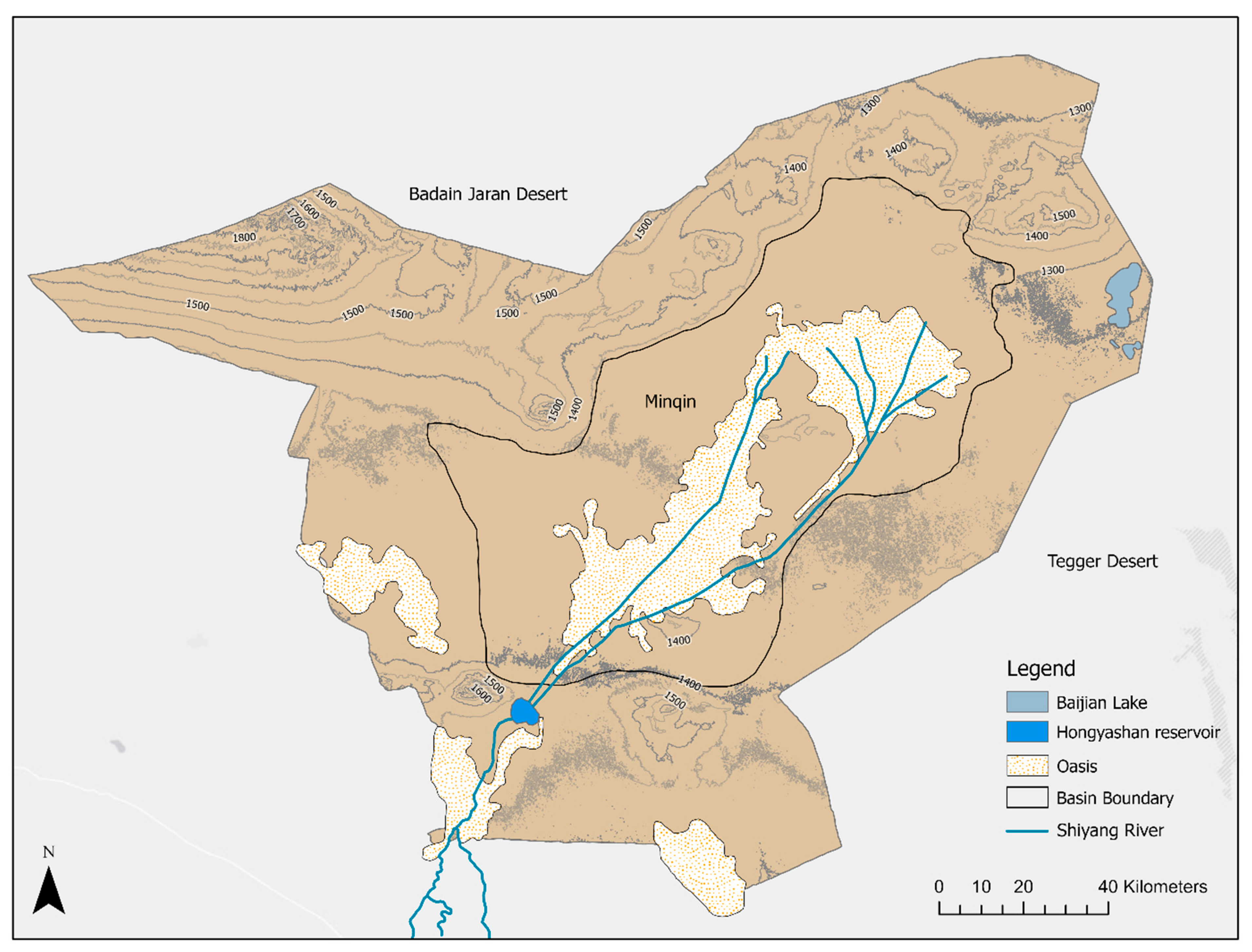Identification of Water-Reuse Potentials to Strengthen Rural Areas in Water-Scarce Regions—The Case Study of Wuwei
Abstract
:1. Introduction
2. Materials and Methods
2.1. A Case Study Analysis of the Water-Scarce Region of Wuwei in China
2.1.1. Population and Population Growth in Wuwei
2.1.2. Climate and Geography
2.1.3. Development of the Agricultural Sector in the Region
2.1.4. Water Resources and Distribution of Use in Wuwei
2.1.5. Impact of High Water Consumption in the Region
2.1.6. Approaches and Measures to Tackle the Challenges of Water Scarcity
2.1.7. Wuwei Increases Greenhouse Agriculture
2.1.8. Discussion: Have the Water Scarcity Challenges for Rural Areas been Addressed?
2.2. Analysis of Water-Reuse Potential for Wuwei by Using Geoinformation Systems
2.2.1. Estimation of Available Wastewater Flows in Wuwei
2.2.2. Potential Analysis to Increase Water-Reuse by Building Clusters for Wastewater Treatment Options
3. Results
3.1. Recommendations for Implementing Reuse Water Under Consideration of the Quality Requirements
3.2. Increase in Water-Reuse in Wuwuei
4. Further Impacts for Optimizing Water-Reuse Concepts
4.1. Land-Use and Water Requirements
4.2. Costs for Implementing Water-Reuse
5. Conclusions
Funding
Conflicts of Interest
References
- Zhu, X.; Li, Y.; Li, M.; Pan, Y.; Shi, P. Agricultural irrigation in China. J. Soil Water Conserv. 2013, 68, 147A–154A. [Google Scholar] [CrossRef] [Green Version]
- Lyu, S.; Chen, W.; Zhang, W.; Fan, Y.; Jiao, W. Wastewater reclamation and reuse in China: Opportunities and challenges. J. Environ. Sci. 2016, 39, 86–96. [Google Scholar] [CrossRef] [PubMed]
- Dong, H.-Y.; Qiang, Z.-M.; Wang, W.-D.; Jin, H. Evaluation of rural wastewater treatment processes in a county of eastern China. J. Environ. Monit. 2012, 14, 1906–1913. [Google Scholar] [CrossRef] [PubMed]
- Wang, J.; Huang, J.; Rozelle, S. Climate Change and China’s Agricultural Sector: An Overview of Impacts, Adaptation and Mitigation; International Centre for Trade and Sustainable Development: Geneva, Switzerland; International Food & Agricultural Trade Policy Council: Washington, DC, USA, 2010. [Google Scholar]
- Jiménez, B.; Asano, T. Water Reuse: An International Survey of Current Practice, Issues and Needs; IWA Publishing: London, UK, 2008. [Google Scholar]
- Jaramillo, M.F.; Restrepo, I. Wastewater Reuse in Agriculture: A Review about Its Limitations and Benefits. Sustainability 2017, 9, 1734. [Google Scholar] [CrossRef] [Green Version]
- Udimal, T.B.; Jincai, Z.; Ayamba, E.C.; Owusu, S.M. China’s water situation; the supply of water and the pattern of its usage. Int. J. Sustain. Built Environ. 2017, 6, 491–500. [Google Scholar] [CrossRef]
- Bauer, S.; Linke, H.J.; Wagner, M. Optimizing water-reuse and increasing water-saving potentials by linking treated industrial and municipal wastewater for a sustainable urban development. Water Sci. Technol. 2020, 81, 1927–1940. [Google Scholar] [CrossRef]
- Bauer, S.; Linke, H.J.; Wagner, M. Combining industrial and urban water-reuse concepts for increasing the water resources in water-scarce regions. Water Environ. Res. 2020, 92, 1027–1041. [Google Scholar] [CrossRef]
- Bauer, S.; Dell, A.; Behnisch, J.; Chen, H.; Bi, X.; Nguyen, V.A.; Linke, H.J.; Wagner, M. Water-reuse concepts for industrial parks in water-stressed regions in South East Asia. Water Supply 2020, 20, 296–306. [Google Scholar] [CrossRef]
- SEMIZENTRAL Integrated Supply and Treatment Systems for Fast-Growing Urban Regions. Federal Ministry of Education and Research (BMBF) Funded Research Project. Available online: www.semizentral.de/en/home/ (accessed on 10 June 2020).
- Wang, L.; Zhao, Y.; Huang, Y.; Wang, J.; Li, H.; Zhai, J.; Zhu, Y.; Wang, Q.; Jiang, S. Optimal Water Allocation Based on Water Rights Transaction Models with Administered and Market-Based Systems: A Case Study of Shiyang River Basin, China. Water 2019, 11, 577. [Google Scholar] [CrossRef] [Green Version]
- Wu, H.; Wang, L.; Liu, L.; Hao, L.; Ma, Q.; Li, F.; Guo, L.; Zhang, X.; Zheng, Y. Groundwater recharge and evolution in the Wuwei Basin, northwestern China. Environ. Earth Sci. 2019, 78, 2179. [Google Scholar] [CrossRef]
- Yue, Q.; Zhang, F.; Guo, P. Optimization-Based Agricultural Water-Saving Potential Analysis in Minqin County, Gansu Province China. Water 2018, 10, 1125. [Google Scholar] [CrossRef] [Green Version]
- Herzfeld, T.; Zhanli, S.; Roelcke, M.; Schimming, D. Water and Agriculture in China: Status, Challenges and Options for Actions. In Proceedings of the Background Paper of GFFA Panel China, Hamburg, Germany, 19 January 2017. [Google Scholar]
- Li, C.; Wang, Y.; Qiu, G. Water and Energy Consumption by Agriculture in the Minqin Oasis Region. J. Integr. Agric. 2013, 12, 1330–1340. [Google Scholar] [CrossRef]
- Feng, S.; Huo, Z.; Kang, S.; Tang, Z.; Wang, F. Groundwater simulation using a numerical model under different water resources management scenarios in an arid region of China. Environ. Earth Sci. 2011, 62, 961–971. [Google Scholar] [CrossRef]
- Ministry of Ecology and Environment of the People’s Republic of China. Announcement on the Publication of the National List of Centralized Sewage Treatment Facilities: List of Centralized Sewage Treatment Facilities in Gansu Province. 2020. Available online: http://www.mee.gov.cn/xxgk2018/xxgk/xxgk01/202004/t20200410_773911.html (accessed on 29 May 2020).
- Gansu Provincial Water Resources Department. 2015 Water Resources Bulletin of Gansu Province. Available online: http://www.mee.gov.cn/xxgk2018/xxgk/xxgk01/202004/W020200410603388429107.pdf (accessed on 10 June 2020).
- Citypopulation. Wŭwēi Shì: Prefecture-Level City in Gānsù 2020. Available online: https://www.citypopulation.de/en/china/gansu/admin/6206__wuwei/ (accessed on 27 May 2020).
- Li, M.; He, B.; Guo, R.; Li, Y.; Chen, Y.; Fan, Y. Study on Population Distribution Pattern at the County Level of China. Sustainability 2018, 10, 3598. [Google Scholar] [CrossRef] [Green Version]
- Li, F.; Zhu, G.; Guo, C. Shiyang River ecosystem problems and countermeasures. Agric. Sci. 2013, 4, 72–78. [Google Scholar] [CrossRef] [Green Version]
- Liu, X.; Shao, X.; Zhao, L.; Qin, D.; Chen, T.; Ren, J. Dendroclimatic Temperature Record Derived from Tree-Ring Width and Stable Carbon Isotope Chronologies in the Middle Qilian Mountains, China. Arct. Antarct. Alp. Res. 2007, 39, 651–657. [Google Scholar] [CrossRef]
- Climate-data: Wuwei Climate (China). Available online: https://en.climate-data.org/asia/china/gansu/wuwei-2625/ (accessed on 15 May 2020).
- Zhang, Y.; Ma, J.; Chang, X.; van Wonderen, J.; Yan, L.; Han, J. Water resources assessment in the Minqin Basin: An arid inland river basin under intensive irrigation in northwest China. Environ. Earth Sci. 2012, 65, 1831–1839. [Google Scholar] [CrossRef]
- Huo, Z.; Feng, S.; Kang, S.; Dai, X.; Li, W.; Chen, S. The Response of Water-Land Environment to Human Activities in Arid Minqin Oasis, Northwest China. Arid Land Res. Manag. 2007, 21, 21–36. [Google Scholar] [CrossRef]
- Sun, D.; Dawson, R.; Li, H.; Li, B. Modeling desertification change in Minqin County, China. Environ. Monit. Assess. 2005, 108, 169–188. [Google Scholar] [CrossRef]
- Gansu Provincial People’s Government: Gansu China. Available online: http://www.gansu.gov.cn/col/col3647/index.html (accessed on 19 May 2020).
- Jarvis, A.; Reuter, H.I.; Nelson, A.; Guevara, E. Hole-filled Seamless SRTM data V4, International Centre for Tropical Agriculture (CIAT). 2008. Available online: http://srtm.csi.cgiar.org (accessed on 1 July 2020).
- Chen, Q.; Wang, C.-L.; Hu, M.; Sun, Y. Greenhouse Production Mode in Wuwei City, Gansu Province and Its Benefits Investigation and Analysis. China Veg. 2013, 22, 92–95. [Google Scholar]
- Global Times. Farmers Busy with Farm Work in Greenhouse Across China. 2020. Available online: http://www.globaltimes.cn/content/1130797.shtml (accessed on 10 June 2020).
- Ji, X.; Kang, E.; Chen, R.; Zhao, W.; Zhang, Z.; Jin, B. The impact of the development of water resources on environment in arid inland river basins of Hexi region, Northwestern China. Environ. Geol. 2006, 50, 793–801. [Google Scholar] [CrossRef]
- O’Connor, N.; Mehta, K. Modes of Greenhouse Water Savings. Procedia Eng. 2016, 159, 259–266. [Google Scholar] [CrossRef] [Green Version]
- Nikolaou, G.; Neocleous, D.; Katsoulas, N.; Kittas, C. Irrigation of Greenhouse Crops. Horticulturae 2019, 5, 7. [Google Scholar] [CrossRef] [Green Version]
- Alamanos, A.; Latinopoulos, D.; Xenarios, S.; Tziatzios, G.; Mylopoulos, N.; Loukas, A. Combining hydro-economic and water quality modeling for optimal management of a degraded watershed. J. Hydroinform. 2019, 21, 1118–1129. [Google Scholar] [CrossRef] [Green Version]
- Brouziyne, Y.; Abouabdillah, A.; Hirich, A.; Bouabid, R.; Zaaboul, R.; Benaabidate, L. Modeling sustainable adaptation strategies toward a climate-smart agriculture in a Mediterranean watershed under projected climate change scenarios. Agric. Syst. 2018, 162, 154–163. [Google Scholar] [CrossRef]
- Gebremedhin, K.; Amba, S.; Lakshman, N. Performance Evaluation of SWAT Model for Land Use and Land Cover Changes under different Climatic Conditions: A Review. Hydrol. Curr. Res. 2015, 6, 3. [Google Scholar] [CrossRef]
- Neissi, L.; Albaji, M.; Nasab, S.B. Site Selection of Different Irrigation Systems Using an Analytical Hierarchy Process Integrated with GIS in a Semi-Arid Region. Water Resour. Manag. 2019. [Google Scholar] [CrossRef]
- Aghaloo, K.; Chiu, Y.-R. Identifying Optimal Sites for a Rainwater-Harvesting Agricultural Scheme in Iran Using the Best-Worst Method and Fuzzy Logic in a GIS-Based Decision Support System. Water 2020, 12, 1913. [Google Scholar] [CrossRef]
- Tolksdorf, J.; Shen, W.; Blach, T.; Leinhos, M.; Wagner, M. Wirtschaftlichkeit semizentraler, integrierter Infrastruktursysteme in schnell wachsenden urbanen Räumen am Beispiel SEMIZENTRAL. (Economy of Semicentral, Integrated Infrastructure Systems in Fast-Growing Urban Areas Using SEMIZENTRAL as an Example). Gwfwasser Abwasser 2019, 3, 73–82. [Google Scholar]
- Lazarova, V.; Choo, K.H.; Cornel, P. Meeting the challenges of the water-energy nexus: The role of reuse and wastewater treatment. Water21 2012, 14, 12–17. [Google Scholar]
- Hilbig, J.; Boysen, B.; Wolfsdorf, P.; Rudolph, K.-U. Economic evaluation of different treatment options for water reuse in industrial parks using modular cost functions. J. Water Reuse Desalin. 2020, in press. [Google Scholar] [CrossRef]
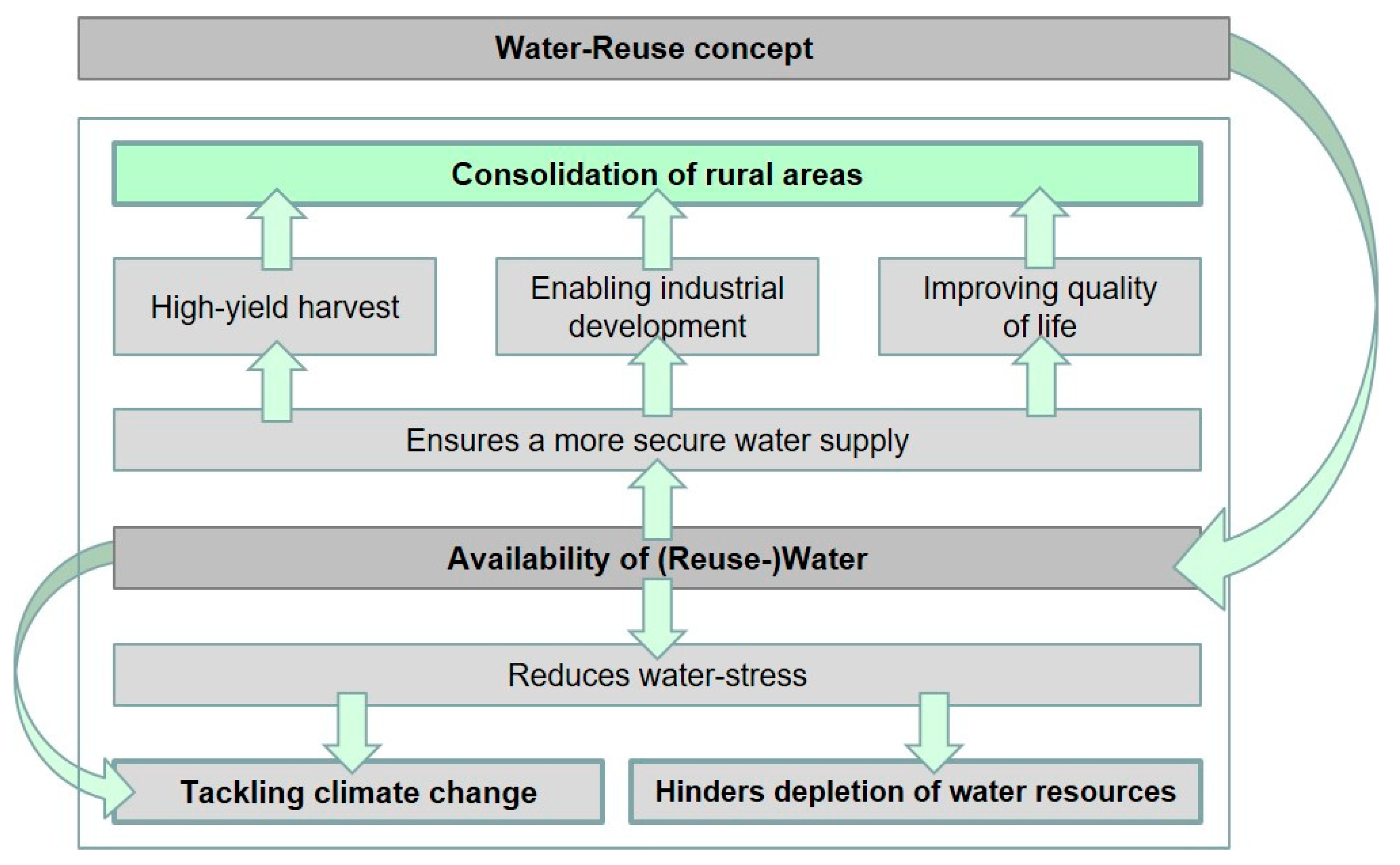
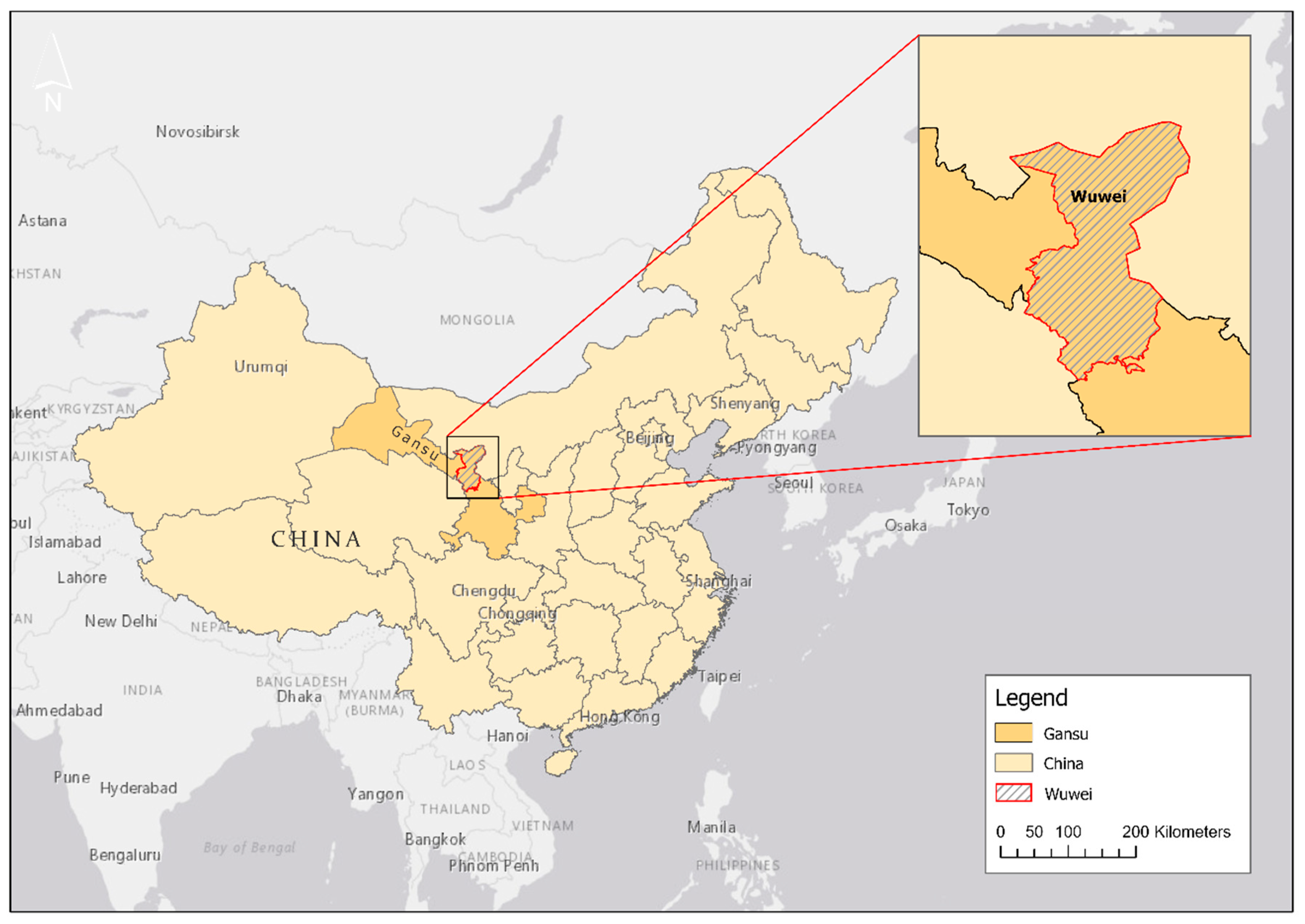
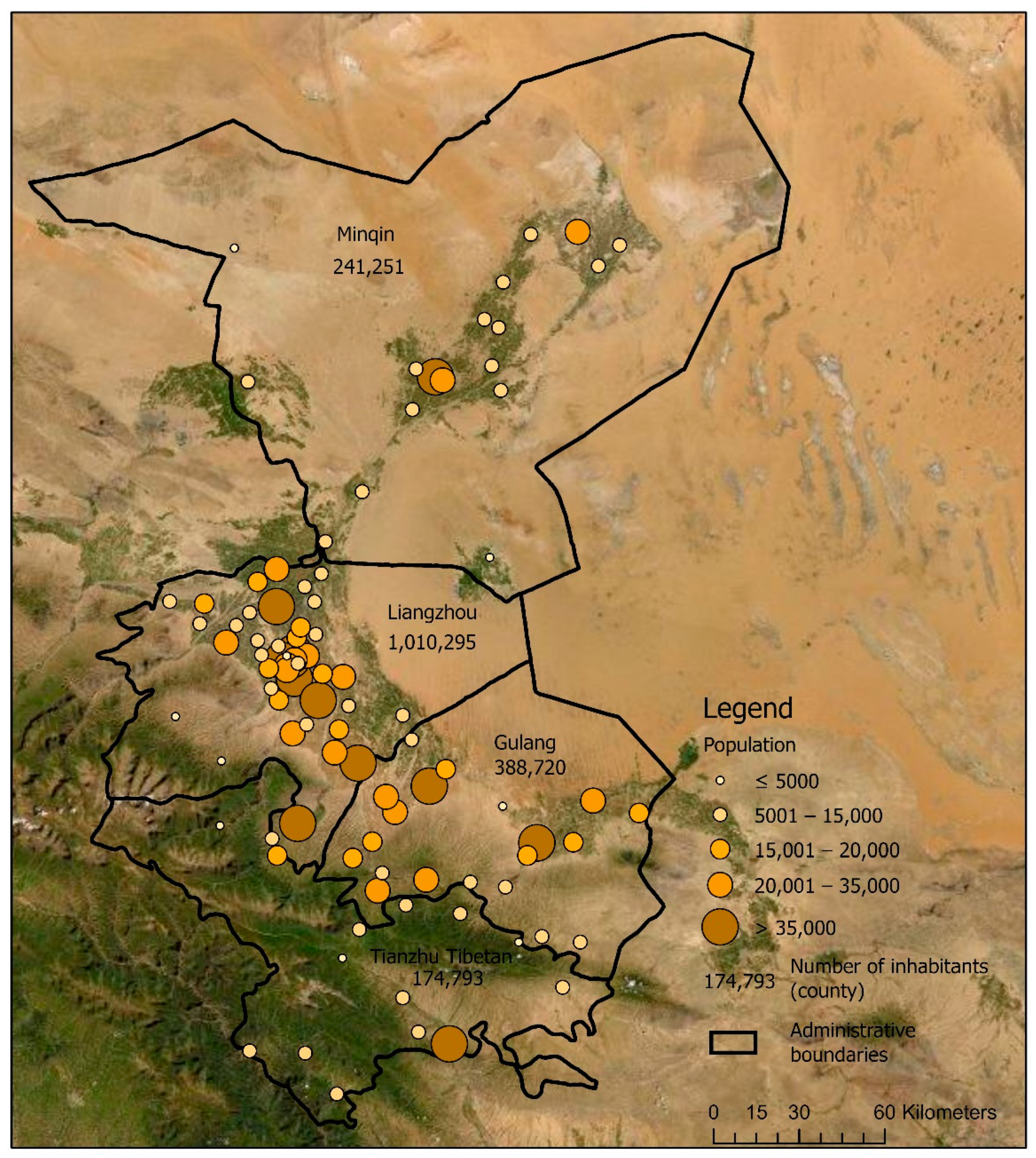
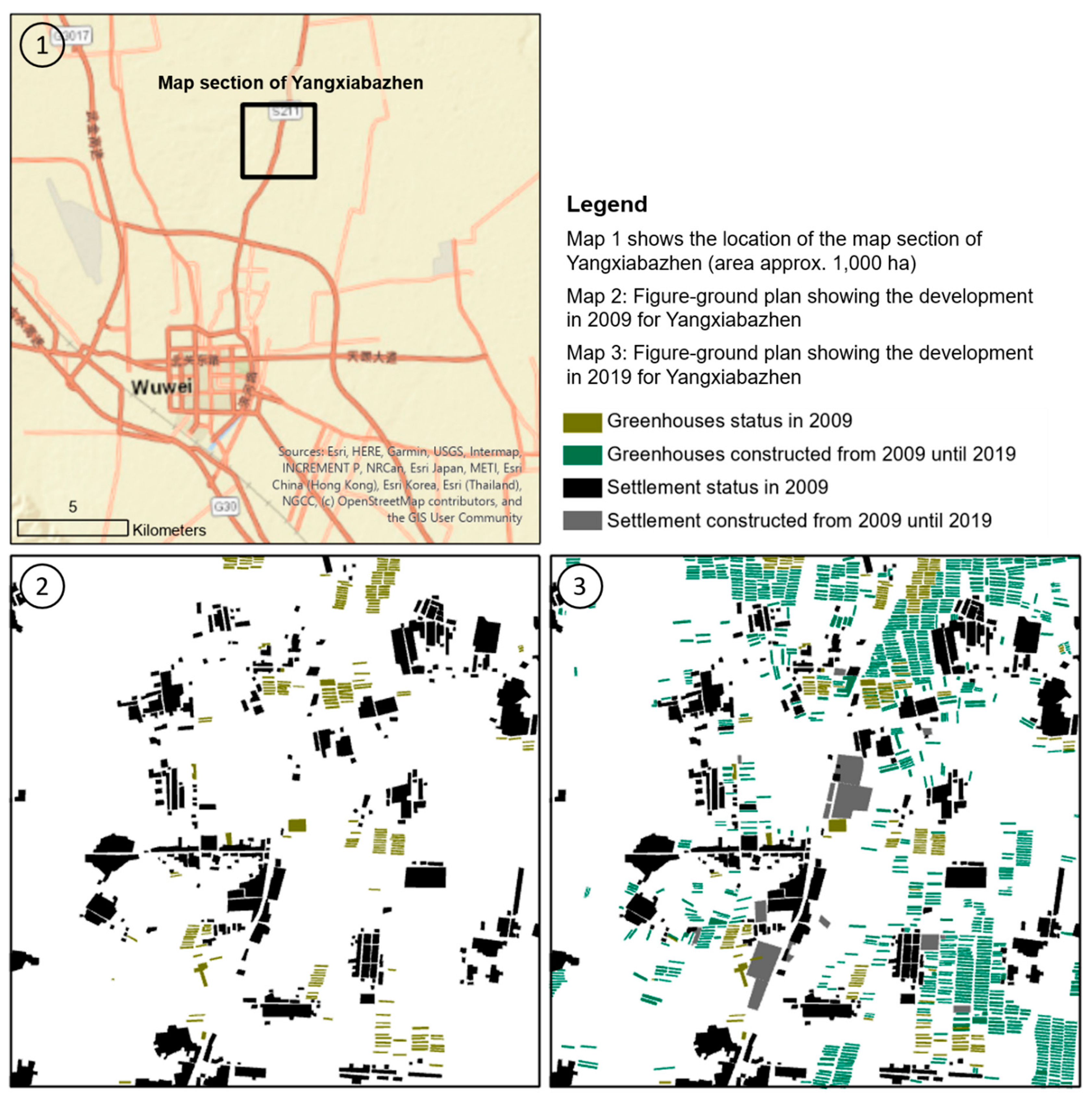

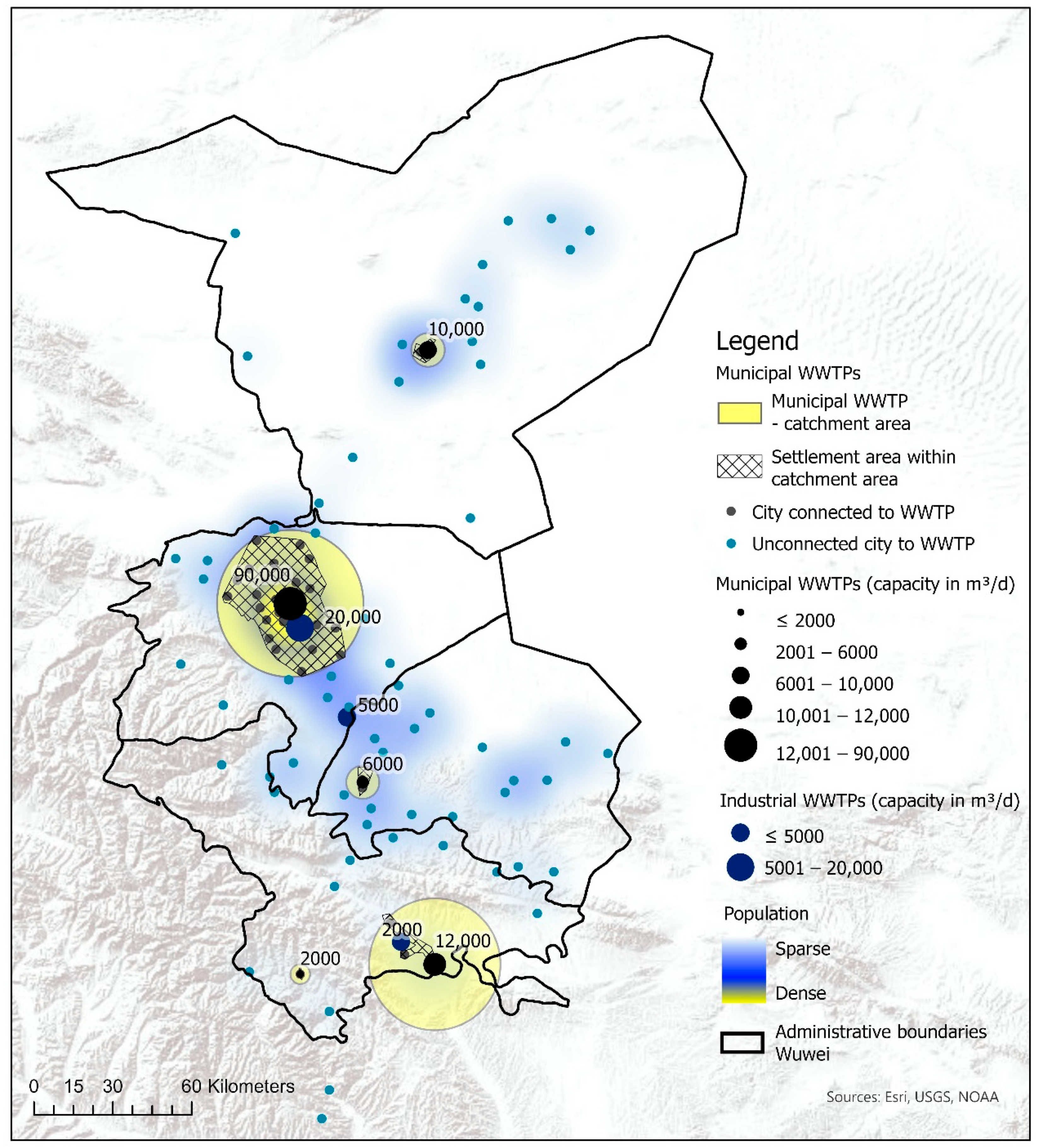
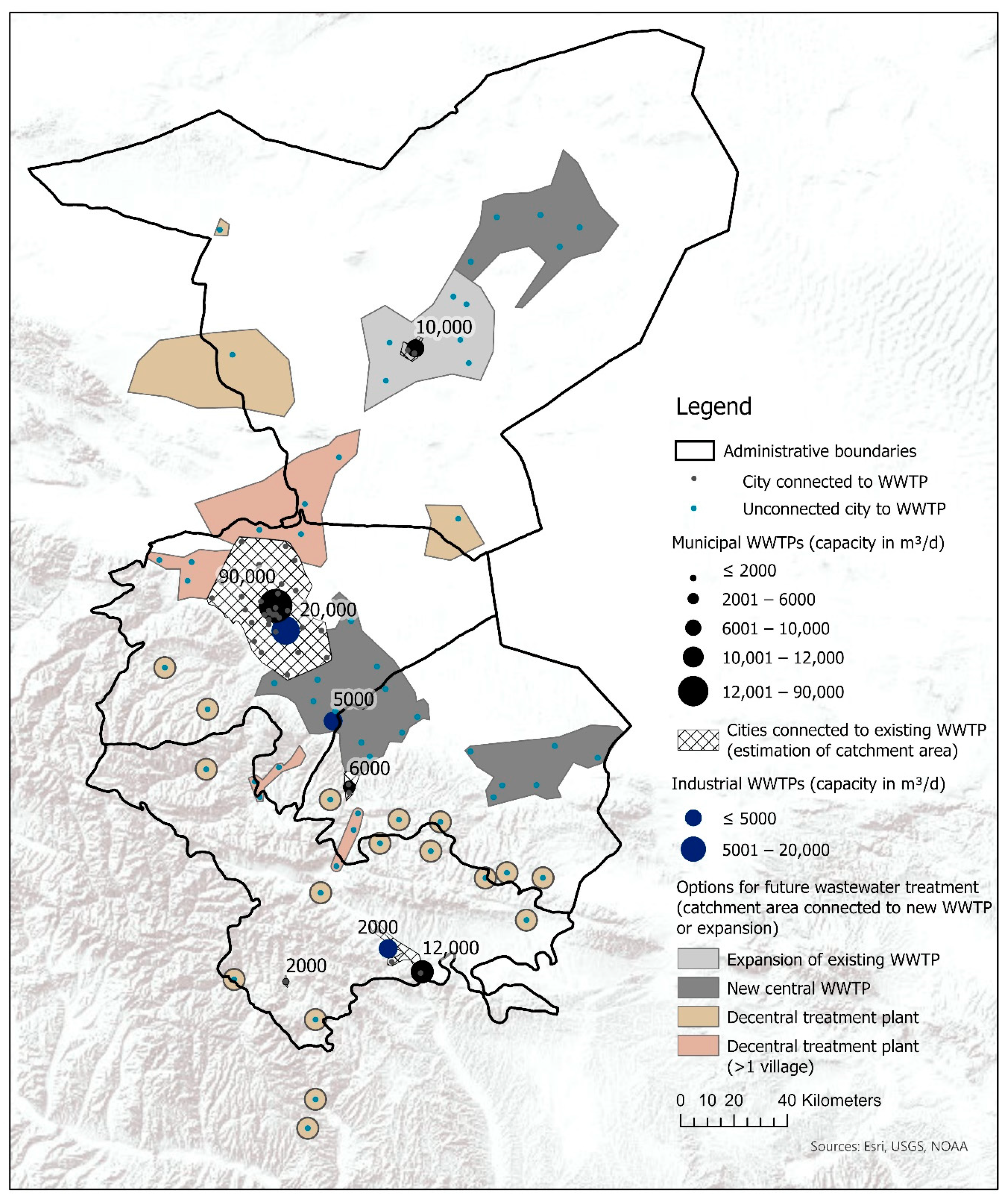
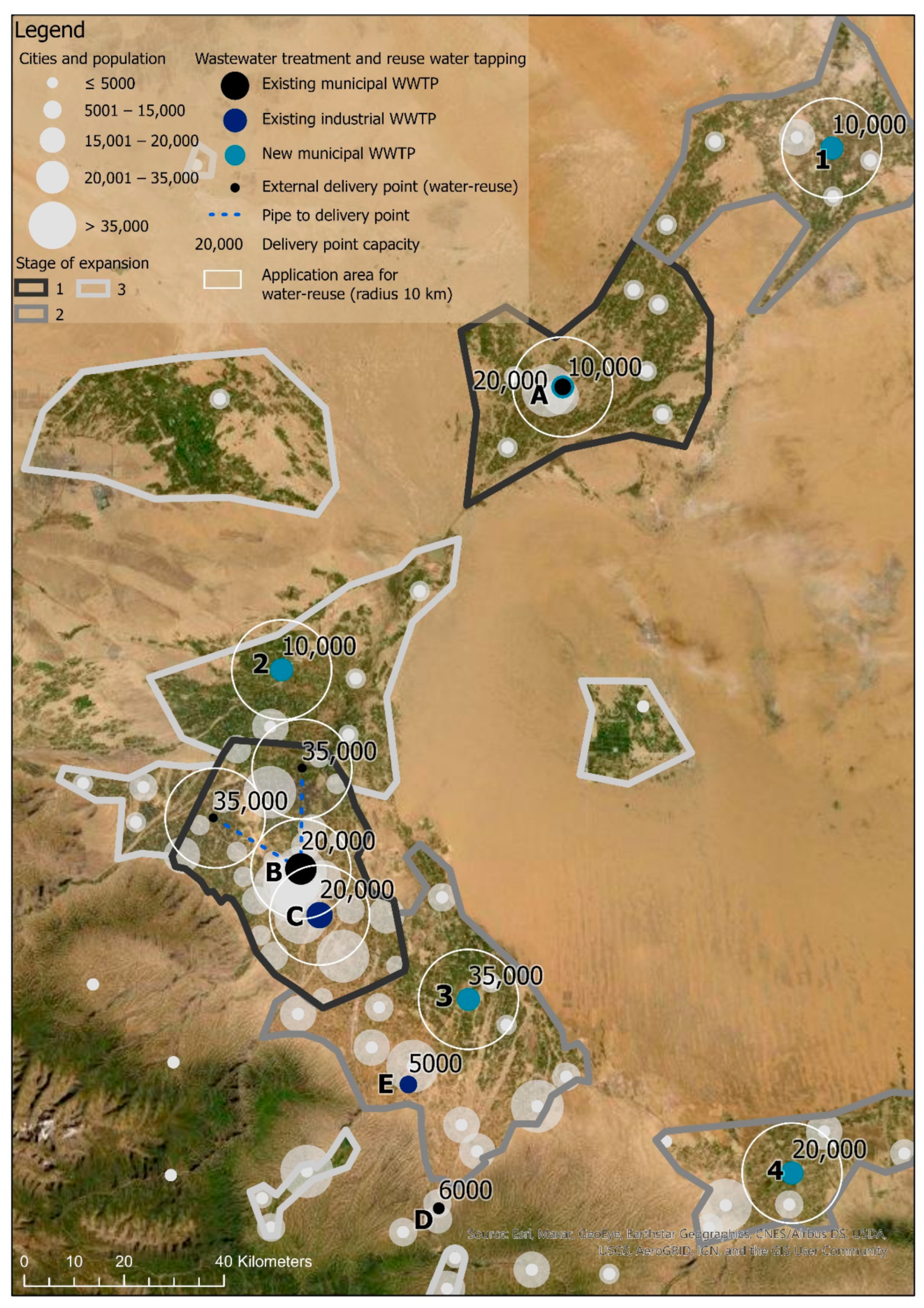
| Field Crop | Cultivation Area 2011 | Cultivation Area 2015 | Increase/Decrease | Irrigation Quota/mm per Growing Season |
|---|---|---|---|---|
| Spring wheat | 7400 ha | 4674 ha | −37% | 350–400 |
| Corn | 5387 ha | 9967 ha | +85% | 400–450 |
| Cotton | 12,827 ha | 5000 ha | −61% | 300–350 |
| Oil Flex | 7160 ha | 11,514 ha | +61% | 300–350 |
| Seed Melon | 2107 ha | 2473 ha | 17% | 350–400 |
| total | 34,881 ha | 33,628 ha | −4% |
| Water Source for Water Supply | Water Supply in Million m3 in 2010 | Water Supply Distribution | |
|---|---|---|---|
| Surface water | 1229 | 64.6% | |
| Groundwater | 664 | 34.9% | |
| Other | Reuse | 2 | 0.1% |
| Rainfall | 7 | 0.4% | |
| Sum | 1902 | 100% | |
| Purpose | Water Consumption in Million m3 in 2010 | Water Consumption Distribution | |
| Agriculture | 1683 | 88.5% | |
| Industrial production | 78 | 4.1% | |
| Domestic use | 48 | 2.5% | |
| Urban public use | 11 | 0.6% | |
| FASF * | 32 | 1.7% | |
| Ecological environment protection | 69 | 3.6% | |
| Sum | 1921 ** | 100% | |
| County | Town | Treatment Capacity [m3/d] | Number of Cities | Population | Wastewater Flows [m3/d] * | Ratio |
|---|---|---|---|---|---|---|
| Estimated connections to a wastewater treatment plant (WWTP) | ||||||
| Liangzhou | Jinyang Zhen | 90,000 1 | 32 | 740,991 | 88,177 | |
| Tianzhu | Huazangsi Zhen | 12,000 1 | 3 | 70,420 | 8381 | |
| Minqin | Suwu Zhen | 10,000 1 | 2 | 74,577 | 8874 | |
| Gulang | Gulang Zhen | 6000 1 | 2 | 37,808 | 4499 | |
| Tianzhu | Tanshanling Zhen | 2000 1 | 1 | 7151 | 851 | |
| Sum | 120,000 1 | 40 | 930,947 | 110,782 | 52% | |
| Liangzhou | Gaoba Zhen | 20,000 2 | - | - | unknown | |
| Liangzhou | Huangyang Zhen | 5000 2 | - | - | unknown | |
| Tianzhu | Kuangou | 2000 2 | - | - | unknown | |
| Sum | 27,000 2 | |||||
| Estimates for cities unconnected to a WWTP | ||||||
| Sum | 61 | 870,335 | 103,571 | 48% | ||
| Total wastewater flows based on Wuwei’s population | ||||||
| Total | 101 | 1,801,282 | 214,353 | 100% | ||
| Water-reuse ratio | ||||||
| Water-reuse ratio related to treated wastewater | ||||||
| 5479 m3/d of 110,782 m3/d is reused | 4.9% | |||||
| Water-reuse ratio related to the total wastewater flow | ||||||
| 5479 m3/d of 214,353 m3/d is reused | 2.6% | |||||
| No. | Recommendation for Action (WWTP) | Type of Reused Water Provision | Wastewater Treatment Capacity [m3/d] | INHABITANTS of Cluster | Wastewater Flow [m3/d] = Reused Water Flow ** | No. of Connected Cities |
|---|---|---|---|---|---|---|
| 1 | Construction of new WWTP | Delivery point at WWTP | 10,000 | 67,354 | 8015 | 5 |
| 2 | Construction of new WWTP | Delivery point at WWTP | 10,000 | 58,492 | 6961 | 4 |
| 3 | Construction of new WWTP | Delivery point at WWTP | 35,000 | 261,538 | 31,123 | 11 |
| 4 | Construction of new WWTP | Delivery point at WWTP | 20,000 | 127,067 | 15,121 | 6 |
| A | Expansion of existing WWTP and modification for water-reuse | Delivery point at WWTP | 20,000 | 145,657 | 17,333 | 8 |
| B | Modification of existing municipal WWTP for water-reuse | Delivery point at WWTP and new pipeline to external delivery points | 90,000 | 740,991 | 88,177 | 32 |
| C | Modification of existing industrial plant for water-reuse | Delivery point at WWTP | 20,000 | - | 20,000 | - |
| D | Modification of existing municipal WWTP for water-reuse | Delivery point at WWTP | 6000 | 37,808 | 4499 | 2 |
| E | Modification of existing industrial WWTP for water-reuse | Delivery point at WWTP | 5000 | - | 5000 | |
| * | Modification of existing municipal WWTP for water-reuse | Delivery point at WWTP | 12,000 | 70,420 | 8381 | 3 |
| * | Modification of existing municipal WWTP for water-reuse | Delivery point at WWTP | 2000 | 7151 | 851 | 1 |
| * | Modification of existing industrial WWTP for water-reuse | Delivery point at WWTP | 2000 | - | 2000 | |
| Sum (expansion phase 1 and 2) | 232,000 | 1,516,478 | 207,461 | 72 | ||
| Sum (current situation) | 147,000 | 930,947 | 5479 | 40 | ||
| Increasing rate (%) by implementing the water-reuse concept | 58% | 63% | 3686% | 80% | ||
| Total | 1,801,282 | 214,353 | 101 | |||
| Coverage ratio in % | 84% | 97% | 71% | |||
Publisher’s Note: MDPI stays neutral with regard to jurisdictional claims in published maps and institutional affiliations. |
© 2020 by the author. Licensee MDPI, Basel, Switzerland. This article is an open access article distributed under the terms and conditions of the Creative Commons Attribution (CC BY) license (http://creativecommons.org/licenses/by/4.0/).
Share and Cite
Bauer, S. Identification of Water-Reuse Potentials to Strengthen Rural Areas in Water-Scarce Regions—The Case Study of Wuwei. Land 2020, 9, 492. https://doi.org/10.3390/land9120492
Bauer S. Identification of Water-Reuse Potentials to Strengthen Rural Areas in Water-Scarce Regions—The Case Study of Wuwei. Land. 2020; 9(12):492. https://doi.org/10.3390/land9120492
Chicago/Turabian StyleBauer, Sonja. 2020. "Identification of Water-Reuse Potentials to Strengthen Rural Areas in Water-Scarce Regions—The Case Study of Wuwei" Land 9, no. 12: 492. https://doi.org/10.3390/land9120492




